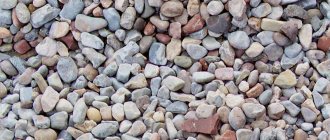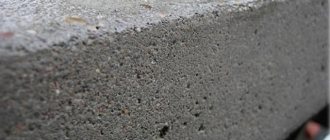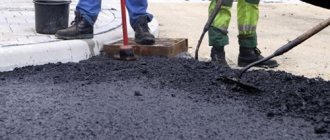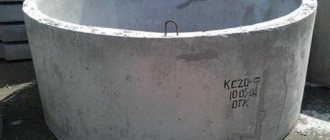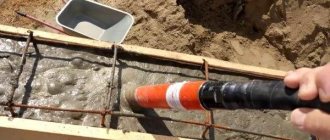Construction work involves the use of crushed stone and gravel. These fine minerals are very similar to each other, but nevertheless different. Both are formed from rocks and are used for almost similar construction work. But still, upon closer examination of these two building materials, significant differences can be identified. This becomes noticeable not only visually, but also practically. Each of them has its own application features. They also interact differently with other materials. During construction, such indicators are very important.
What is crushed gravel?
Crushed gravel
- This is
crushed stone
from loose sedimentary rocks, which consists of rock fragments, sometimes of various minerals, rounded to one degree or another. The formation of gravel occurs in fluvio-glacial deposits, in river beds, as well as in the coastal levees of coasts.
Interesting materials:
What does it mean to give irises? What does independent oven mean? What does independent oven mean? What does Epp mean? What does Fpk mean on a train? What does an inverter motor mean in a vacuum cleaner? What does artificial Swan's down mean? What does potassium fertilizer mean? What does service class 2t mean? What does condensation drying mean?
What is the difference between crushed stone
Crushed stone and gravel are small rocks. The diameters of their particles can be as small as 5 mm and reach up to 200 mm.
You can read about what crushed granite stone GOST 8267 93 is from this article.
The photo shows the difference between crushed stone and gravel:
Differences in production processes
The gravel has a round shape with fuzzy edges. Found in nature in the form of rock particles. It is formed as a result of temporary rock splitting. It is industrially collected from the stone surface using special equipment. Then the gravel undergoes calibration and screening, and, if necessary, washing. As a result, the material obtained after all operations is gravel.
The GOST crushed stone fraction and other characteristics can be read in the article.
The video explains the difference between crushed stone and gravel:
Since it is obtained as a result of the natural and prolonged destruction of rocks, it has not only a smooth surface, but also many foreign inclusions, such as clay, sand, particles of organic substances and others. This leads to the fact that the material must be sorted into fractions, sifted, and in some cases washed, which makes the production process more labor-intensive. But as a result of this, the building material gets rid of impurities.
The difference between gravel and crushed stone can be found in the article.
It consists of various rocks and minerals, so when assessing its strength, the weakest grains from several batches are selected. There are several types of gravel, depending on where the material is mined. There are: sea, river and mountain. It is the mountain subspecies that has found application in construction.
Crushed stone is also the result of crushing rocks, but to obtain it, they do not wait for their natural destruction, but use special equipment. It can be a by-product during mining and processing operations. Several types of technology are used for its production. Depending on the size of the material required, the type of crushing machines is selected. If it is mined in a quarry, then stationary equipment is used, and if in hard-to-reach places, then mobile models are used.
The weight of crushed stone of fraction 20-40 per 1m3 and other characteristics of the building material can be found in the article.
When purposefully extracting crushed stone, a rock explosion is first carried out; for this, a hole is cut in the mountain rocks into which explosives are placed. After the explosion, experts check the size of the rock fragments, and if the stone is large, it is undermined again.
After this, using special machines, the resulting fragments are delivered to crushing and screening machines (mills and screens), and they crush the rock to the required size.
In the case of mining and processing operations, crushed stone is obtained as a by-product. The resulting rocks are sifted, and after that the “empty” fraction, which does not contain the necessary substances, is selected. Most often, blasting is used to produce crushed stone, so its extraction is more labor-intensive than gravel.
For those who want to know how much sand, crushed stone, cement is in a cube of concrete, you can find out from the article.
What does gravel look like?
Externally, you cannot confuse these materials and how they look. Let's start with the fact that crushed stone is presented in one gray color, while gravel has different colors, so it is more often used for decoration. Unlike crushed stone, it has clear shapes formed by nature.
Depending on the location of extraction, gravel is divided into the following types:
- mountain;
- granite;
- nautical;
- river.
The article describes the fraction of crushed stone 40 70 and other characteristics of the building material.
Streamlined shapes due to contact with water have a river and marine appearance, so it is more often used for decorative purposes, since its rounded edges do not adhere well to other substances. For concrete work, glacial (granite) and mountain crushed stone is used. The latter varieties can be confused with each other.
Gravel is divided into three subgroups depending on the parameters of its particles:
- small stones, the size of which reaches from 1 mm to 1.25;
- medium, reaching 5 mm;
- large particles over 10 mm.
Compared to gravel, crushed stone has a more angular and rough shape, thanks to which it is more in demand in construction. It has excellent adhesion to other materials and is a good filler for construction voids.
For those who want to know what the volumetric weight of crushed stone is, it is worth reading this article.
Dimensions are related to the scope of its application:
- minimum fractions of up to 5 mm are used for roads; they are used to sprinkle paths against ice;
- over 5 and up to 10 mm are used in concrete work and the production of building slabs;
- stones up to 20 mm are used in the construction of bridges and serve as the basis for asphalt roads, and are also used when pouring foundations for buildings;
- fractions over 20 mm, but less than 40 are used for the construction of complex structures;
- up to 70 mm – participate in the construction of multi-storey buildings;
- over 70 and up to 120 mm are used for decorative purposes.
You can find out the differences between crushed stone and gravel here in the article.
Crushed stone has high strength and resistance to low temperatures. According to the degree of frost resistance, it has several groups. As you can see, crushed stone is more varied in size than gravel.
Interaction with other materials
Considering the fact that gravel has more rounded shapes, it is significantly inferior in adhesion characteristics to other building materials compared to crushed stone. The presence of corners and a rough plane in the latter contributes to better bonding with concrete and optimal compaction. It is capable of filling any construction voids. For example, when constructing a rubble foundation, they, together with cement, fill the internal part, made of large stones that do not fit tightly together.
Areas of application
The characteristics of crushed stone have found application in construction work during the construction of reinforced concrete structures and concrete objects. Its finest fraction is used for sprinkling paths during icy conditions, as well as for leveling sports fields.
For those who are interested in knowing what heavy concrete consists of, you can read this article.
Due to its decorative form, gravel is used more often in landscape design:
- when decorating garden paths and flower beds;
- for decorating building facades;
- they make models of ponds;
- it is filled in on the site of roads and various recreation areas.
Gravel is also used in construction as a “cushion” in the foundation. It is also useful to read about the use of pebbles in landscape design.
Technical characteristics of crushed limestone
Crushed limestone is formed from calcium carbonate. This crushed stone is also called dolomite crushed stone. Limestone crushed stone is used for construction along with other types of crushed stone.
Main technical characteristics of crushed limestone:
Fractional composition - limestone crushed stone is produced in three fractions of the following sizes: 5-20 mm, 20-40 mm and 40-70 mm.
Strength – for the construction of roads with light traffic loads, limestone crushed stone with a strength of 200 kg/cm2 is used. For the construction of roads with average transport activity, dolomite crushed stone with a strength of 300 to 600 kg/cm2 is used. For industrial roads, crushed limestone with a strength of 600 to 800 kg/cm2 is used.
Frost resistance is a number that determines the number of freezing and thawing cycles; crushed limestone is 300.
Adhesion - determined by visual inspection of the material; the darker the color, the higher this indicator.
Radioactivity is an important characteristic of crushed stone. Determined by the conclusion of the sanitary-epidemiological service. The radioactivity of crushed limestone is no more than 370 Bq/kg.
Crushed stone or asphalt chips
Before moving on to comparing materials, it is necessary to determine what asphalt chips are.
Asphalt crumb (or asphalt chips or asphalt granulate) is a secondary material obtained by cold milling old asphalt concrete or by crushing large fragments of removed asphalt pavement. The composition of the crumb includes particles of bitumen and small crushed stone measuring 3-5 mm. in diameter, may contain a small amount of sand, rubber inclusions, cement and other elements.
Advantages, features
The main advantages and positive features of asphalt crumbs include:
- reasonable price, allowing the material to stand out favorably against the background of crushed stone and gravel;
- simplicity and high compaction density;
- high resistance to atmospheric influences;
- significant service life without repair;
- the presence of fusible bitumen in the composition ensures uniformity of the finishing coating;
- laying can be done without the use of special road repair equipment; improvised means are suitable for leveling and compacting; it is possible to use a car;
- installation does not require surface preparation, which also does not require a substrate;
- efficiency of project implementation, a crumb road can be laid in a short time;
- during operation, the crumb web only becomes more monolithic;
- Light weight makes delivery and installation easy.
The disadvantages are a greater impact on the environment compared to crushed stone and the need for periodic renewal of the road surface (this disadvantage is not limited to asphalt chips).
Areas of application
Low cost and ease of operation ensure the demand for the material, so the crumb is used:
- for arrangement of parking lots and paths in private areas;
- when paving suburban, secondary, access roads; for the construction of roads of the first category, the use of crumbs is not recommended, since the material is subject to wear;
- during the construction of sports and training complexes, football fields, basketball courts and tennis courts;
- when arranging a blind area during the construction of garages and small residential buildings, dachas;
- for installing floors, in particular garage floors;
- to strengthen roadsides;
- for eliminating road potholes and holes, filling ditches and uneven areas.
What's better
There is no clear answer to the question - what is better, crushed stone or asphalt chips? - No. Based on the information presented above about the list of works performed using crumbs, it is possible to conclude that the material is suitable for road and construction work . Asphalt chips can be used for landscape work, but the material is not very popular as a decorative element.
When implementing projects, crushed stone, gravel, chips, sand and screenings perform essentially similar functions. Therefore, when choosing, you should take into account the initial data. First, the budget. The price of crumbs is lower, but crushed stone has less harmful effects. Secondly, the initial data. For example, when building a road, it is necessary to take into account the condition and water content of the soil. The less durable the base, the more suitable crushed stone is. Conversely, dry conditions allow the use of crumb filling.
Specifications
Crushed stone of this type not only has good qualities, but also meets a number of important characteristics in accordance with GOST 8267 93:
- Rock strength M800 - M1000;
- Flakiness (particle shape) - 7 - 17%. One of the most important characteristics. The most preferred shape is cuboid, since flat particles will not fit tightly together. This makes it possible to reduce the density of the embankment;
- Density - 2400 m/kg3;
- Frost resistance F150. Withstands up to 150 periods of thawing and freezing;
- Class 1 radioactivity. This means that crushed gravel is not only unable to emit it, but also absorb it. This characteristic is an order of magnitude higher than that of the granite type of crushed stone;
- Weak breeds make up 1.5% or less;
- Do not have foreign harmful impurities;
- Clay and other dust particles occupy only 0.6% of the total strength. This allows us to talk about the best susceptibility to binding materials;
- The bulk density of different fractions, as a rule, does not differ. Usually it is about 1.3 tons, but it is possible less, since this characteristic will depend on the origin or place of its extraction.
